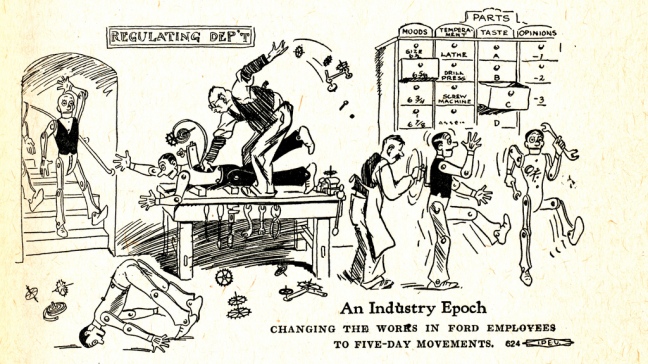What’s the opposite of ‘digital Taylorism’?

Taylorism is also known as the theory of ‘Scientific Management’ established by Frederick Taylor in the 19th century:
Scientific management was a theory of management that analyzed and synthesized workflows. Its main objective was improving economic efficiency, especially labor productivity. It was one of the earliest attempts to apply science to the engineering of processes and to management… Although scientific management as a distinct theory or school of thought was obsolete by the 1930s, most of its themes are still important parts of industrial engineering and management today. These include analysis; synthesis; logic; rationality; empiricism; work ethic; efficiency and elimination of waste; standardization of best practices; disdain for tradition preserved merely for its own sake or merely to protect the social status of particular workers with particular skill sets; the transformation of craft production into mass production; and knowledge transfer between workers and from workers into tools, processes, and documentation. (Wikipedia)
Why Taylorism is A Bad Thing
Although Frederick Taylor did try and remedy his system, the effects on human labour were mostly negative:
[Taylor] failed to leave room in his system for the workers who did have talent or intelligence. Some of them would be duly utilized during the early phases (the studying and designing), but what about smart workers in years afterwards who would start out among the ranks of the drones? What opportunities would they have for career advancement or socioeconomic advancement? He also failed to properly consider the fate of the drone-ish workers themselves. Maybe they did lack the ability for higher-level jobs, but what about keeping them satisfied or placated in their existing roles? Taylorism took some steps toward addressing their needs (for example, Taylor advocated frequent breaks and good pay), but Taylor nevertheless had a condescending view of less intelligent workers, whom he sometimes compared to draft animals. (Wikipedia)
One of the reasons why some people are anti-PRINCE2 as a project management methodology is due to an unthinking application of its management products (as opposed to contextualising the principles of PRINCE2). This is a form of Taylorism. Unfortunately, many promising initiatives and methods are disfigured on the Procrustean bed of top-down management ‘solutions’.
What is digital Taylorism?
If the twentieth century brought what can be described as mechanical Taylorism characterised by the Fordist production line, where the knowledge of craft workers was captured, codified and re-engineered in the shape of the moving assembly line by management, the twenty- first century is the age of digital Taylorism. This involves translating knowledge work into working knowledge through the extraction, codification and digitalisation of knowledge into software prescripts and packages that can be transmitted and manipulated by others regardless of location. (Phil Brown, UKCES – PDF)
Whilst honing workflows to be more productive is definitely a good thing, doing so at the expense of judgement, creativity and autonomy is not:
Digital Taylorism enables innovation to be translated into routines that might require some degree of education but not the kind of creativity and independence of judgement that is often associated with the knowledge economy. In order to reduce costs and assert proprietary rights, companies are experimenting with new ways to move from knowledge work to working knowledge; that is, from the idiosyncratic knowledge that a worker has and applies, to working knowledge, where that knowledge is codified and routinised, thereby making it generally available to the company rather than being the ‘property’ of an individual worker. (Phil Brown, UKCES – PDF)
In other words, anything that can be mechanised, routinised and outsourced, will be. It’s akin to the famous quotation by Arthur C. Clarke: “Teachers that can be replaced by a machine should be.”
What’s the opposite of digital Taylorism?
Most of the important things in life and work can’t be measured and quantified. However, there are measures which pertain to something secondary to the important things. Take online ‘engagement’, for example. Whilst the number of visitors and time spent on each web page aren’t directly linked to engagement, they do serve as a secondary indicators. Getting to the nub of the matter would mean qualitative data (through interviews and the like) rather than hard, impersonal, quantitative web stats.
During my time in schools I saw digital Taylorism and over-quantification entering what used to be called ‘the teaching profession’. Students are reduced to numbers on a spreadsheet and expected to show ‘progress’ (whatever that means) in a linear fashion. Teachers end up conspiring by fudging the numbers so as not to look bad. A similar situation pervades the roles of people I deal with in my current position: they’re constrained by top-down micro-management and a false sense of ‘accountability’.
I’m fortunate that my role at JISC infoNet is the opposite of digital Taylorism. I’m encouraged to network, follow serendipitous connections and think about the ways in which what I’m doing (or could be doing) relates to the core mission of my organisation, the wider role of JISC, and helps the sector more widely. As with the ‘engagement’ example, organisational culture is difficult to measure directly but the large beanbags, sofas, flexible working practices and Investors in People Award serve as secondary indicators!
Image CC BY-NC-SA Tobias Higbie
